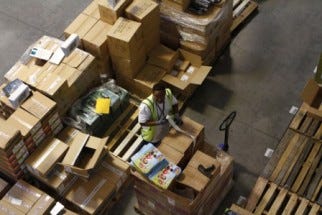Walmart, Amazon work to cut down "wrap rage"
January 30, 2014

[[from Bloomberg]]

Amazon fulfillment center
Amazon.com Inc. and Wal-Mart Stores Inc. are prodding more manufacturers to change their packaging to cut waste and alleviate "wrap rage," the frustration felt when a product is difficult to open.
The nation's largest online store and the world's biggest retailer have been pushing vendors, including Procter & Gamble Co. and Bluetooth headset maker Plantronics Inc., to eliminate excessive and cumbersome packing materials, such as hard plastic clamshell casings that enclose electronics and wire ties used to secure toys to cardboard backings.
"We've gotten e-mails from customers who've purchased scissors in a clamshell, which would require another pair of scissors to open the package," Nadia Shouraboura, Amazon's vice president of global fulfillment, said in an interview.
As much as a third of all consumer trash sent to landfills is estimated to be packaging, according to the Environmental Protection Agency. That translates to more than 800 pounds of packaging waste each year per U.S. consumer.
The problem becomes especially acute during the holidays. From Thanksgiving to New Year's Day, household waste in the U.S. increases 25 percent, according to the EPA.
Besides impregnable packaging, manufacturers have been criticized for not using enough recycled or sustainable materials. This year, Greenpeace targeted toy companies Hasbro Inc., Mattel Inc., Lego Group and Walt Disney Co. to stop using packaging derived from rain forests in Indonesia. In response, the companies pledged to change their packaging practices.
From 19 to 80,000
Amazon kicked off its "Frustration-Free Packaging" initiative in 2008 with 19 items from Mattel and its Fisher- Price brand, Microsoft Corp. and memory-card maker Transcend Information Inc. It has grown to 80,000 products this year, with more than 12 million items expected to ship under the program. Amazon wants to at least triple that number next year.
To help it reach that goal, the retailer is contacting more manufacturers that get poor customer feedback about their packaging. Amazon is also sending engineers to help companies improve their designs.
While reduced packaging can boost consumers' satisfaction, lower shipping costs and appeal to the environmentally conscious, companies are balancing those benefits with the need for packaging that still prevents theft and damage.
Changes at Plantronics
Ken Kannappan, Plantronics' chief executive officer, asked the company's design team this year to take over packaging from the marketing department.
Some early solutions included removing user manuals from boxes, bulk shipping products to retailers and corporate customers without boxing items individually, and reshaping boxes into smaller form factors by replacing AC chargers with USB cables.
"You're looking at packaging and you're going, 'My gosh, this is an area that's designed to be wasted,'" Kannappan said in an interview. "We're trying not only to optimize our packaging to reduce waste but to fully rethink what packaging is and does."
By 2013, Wal-Mart plans to reduce packaging by 5 percent compared with 2008 levels, saving an estimated $3.4 billion annually.
To do so, it's relying more on a sustainability packaging scorecard to determine which products to stock. Wal-Mart is also pushing manufacturers to create innovative design solutions.
Recyclable Messenger Bag
Hewlett-Packard Co. won a Wal-Mart design challenge by wrapping a notebook computer in a protective messenger bag made of recycled materials. It replaces conventional Styrofoam and cardboard packaging.
The design reduced packaging by 97 percent and removed the equivalent of one out of every four trucks it previously needed to ship the computers to Wal-Mart and Sam's Club stores, the company said on its website.
Amazon, based in Seattle, launched its initiative after Chief Executive Officer Jeff Bezos recounted how he had spent his Christmas struggling to open presents for his children.
Bezos described his "wrap rage" as "the frustration we humans feel when trying to free a product from a nearly impenetrable package," according to a letter he wrote to Amazon's customers.
As Bezos shared his story with the staff, "everybody in the room started to chime in with their own horror stories," Shouraboura said. "It was clear what we needed to do."
Source: Bloomberg
You May Also Like


